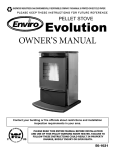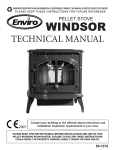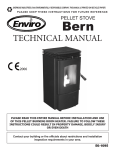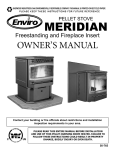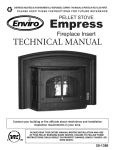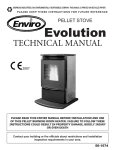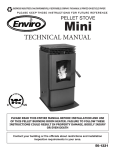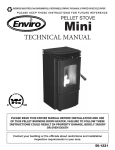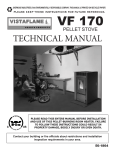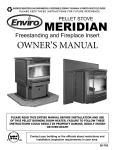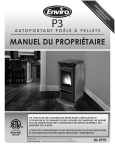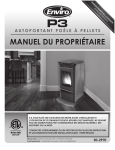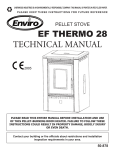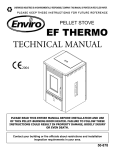Download Enviro Empress Owner`s manual
Transcript
SHERWOOD INDUSTRIES IS AN ENVIRONMENTALLY RESPONSIBLE COMPANY. THIS MANUAL IS PRINTED ON RECYCLED PAPER. PLEASE KEEP THESE INSTRUCTIONS FOR FUTURE REFERENCE PELLET STOVE Empress-A-FS TECHNICAL MANUAL Contact your building or fire officials about restrictions and installation inspection requirements in your area. PLEASE READ THIS ENTIRE MANUAL BEFORE INSTALLATION AND USE OF THIS PELLET-BURNING ROOM HEATER. FAILURE TO FOLLOW THESE INSTRUCTIONS COULD RESULT IN PROPERTY DAMAGE, BODILY INJURY OR EVEN DEATH. 50-1267 Table of Contents Introduction...................................................................................................................................3 Rating Label Location...........................................................................................................3 Important Safety Data.........................................................................................................3 Safety Warnings And Recommendations................................................................................3 Installation.....................................................................................................................................5 Deciding Where to Locate your Pellet Appliance.....................................................................5 Removing Pellet Stove From Pallet........................................................................................5 Dimensions.........................................................................................................................6 Clearances to Combustibles..................................................................................................6 Alcove Clearances................................................................................................................7 Mobile Home Installation......................................................................................................7 Exhaust And Fresh Air Intake Locations.................................................................................8 Outside Fresh-Air Connection................................................................................................8 Vent Termination Requirements.............................................................................................9 Corner Through Wall Installation.........................................................................................10 Horizontal Exhaust Through Wall Installation........................................................................10 Vertical Rise with Horizontal Termination Installation (Recommended)....................................12 Through Concrete Wall With Vertical Rise Installations..........................................................12 Inside Vertical Installations.................................................................................................13 Outside Vertical Installations...............................................................................................14 Hearth Mount Installation...................................................................................................15 Installation with Exterior Mounted Exhaust Blower................................................................16 Through Wall Vertical Installation With Exhaust Blower..........................................................18 Thermostat Installed..........................................................................................................19 Slider/Damper Setting........................................................................................................19 Troubleshooting............................................................................................................................21 Wiring Diagram.............................................................................................................................24 Parts List - Components...............................................................................................................25 Parts List - Cast...........................................................................................................................27 Parts Diagram - Components..........................................................................................................29 Parts Diagram - Steel & Cast..........................................................................................................30 Warranty......................................................................................................................................31 Installation Data Sheet..................................................................................................................34 2 Introduction * This manual is designed for the technician in conjunction with the owner’s manual. * IMPORTANT SAFETY DATA: Please read this entire Owner’s Manual before installing or operating this ENVIRO Pellet Stove. Failure to follow these instructions may result in property damage, bodily injury or even death. Contact your local building or fire official to obtain a permit and any information on installation restrictions and inspection requirements for your area. To prevent the possibility of a fire, ensure that the appliance is properly installed by adhering to the installation instructions. An ENVIRO dealer will be happy to assist you in obtaining information with regards to your local building codes and installation restrictions. Be sure to maintain the structural integrity of the home when passing a vent through walls, ceilings, or roofs. The stove’s exhaust system works with negative combustion chamber pressure and a slightly positive chimney pressure. It is very important to ensure that the exhaust system be sealed and airtight. The ash pan and viewing door must be locked securely for proper and safe operation of the pellet stove. Do not burn with insufficient combustion air. A periodic check is recommended to ensure proper combustion air is admitted to the combustion chamber. Setting the proper combustion air is achieved by adjusting the slider damper located on the left side of the stove. When installing the stove in a mobile home, it must be electrically grounded to the steel chassis of the home and bolted to the floor. Make sure that the structural integrity of the home is maintained and all construction meets local building codes. Minor soot or creosote may accumulate when the stove is operated under incorrect conditions such as an extremely rich burn (black tipped, lazy orange flames). If you have any questions with regard to your stove or the above-mentioned information, please feel free to contact your local dealer for further clarification and comments. SAFETY WARNINGS AND RECOMMENDATIONS: Caution: Do not connect to any air distribution duct or system. Do not burn garbage or flammable fluids such as gasoline, naptha or engine oil. Unit hot while in operation. Keep children, clothing and furniture away. Contact may cause skin burns. SOOT: Operation of the stove with insufficient combustion air will result in the formation of soot which will collect on the glass, the heat exchanger, the exhaust vent system, and may stain the outside of the house. This is a dangerous situation and is inefficient. Frequently check your stove and adjust the slider/ damper as needed to ensure proper combustion. See: “INSTALLATION - SLIDER/DAMPER SETTING”. 3 Introduction ELECTRICAL: The use of a surge protected power bar is recommended. The unit must be grounded. The grounded electrical cord should be connected to a standard 120 volts, 60 hertz electrical outlet and also must be accessible. If this power cord should become damaged, a replacement power cord must be purchased from the manufacturer or a qualified ENVIRO dealer. Be careful that the electrical cord is not trapped under the appliance and that it is clear of any hot surfaces or sharp edges. This unit’s maximum power requirement is (4.1 Amps) 500 watts. GLASS: Do not abuse the glass by striking or slamming the door. Do not attempt to operate the stove with broken glass. The stove uses ceramic glass. Replacement glass must be purchased from an ENVIRO dealer. Do not attempt to open the door and clean the glass while the unit is in operation or if glass is hot. To clean the glass, use a soft cotton cloth and mild window cleaner, gas or wood stove glass cleaner, or take a damp paper towel and dip into the fly ash. This is a very mild abrasive and will not damage the glass. FLAMMABLE LIQUIDS: Never use gasoline, gasoline-type lantern fuel, kerosene, charcoal lighter fluid, or similar liquids to start or “freshen up” a fire in the heater. Keep all such liquids well away from the heater while it is in use. SMOKE DETECTOR: Smoke detectors should be installed and maintained in the structure when installing and operating a pellet burning appliance. OPERATION: The ash pan and door must be closed securely for proper and safe operation of the pellet stove. Also ensure all gaskets on the door are checked and replaced when necessary. INSTALLATION: Be sure to maintain the structural integrity of your home when passing a vent through walls, ceilings, or roofs. It is recommended that the unit be secured into its position in order to avoid any displacement. DO NOT INSTALL A FLUE DAMPER IN THE EXHAUST VENTING SYSTEM OF THIS UNIT. DO NOT CONNECT THIS UNIT TO A CHIMNEY FLUE SERVING ANOTHER APPLIANCE. FRESH AIR: Outside Fresh Air is optional. Consider all large air moving devices when installing your unit and provide room air accordingly. Limited air for combustion may result in poor performance, smoking and other side effects of poor combustion. If you have any questions with regards to your stove or the above-mentioned information, please feel free to contact your local dealer for further clarification and comments. SINCE SHERWOOD INDUSTRIES LTD. HAS NO CONTROL OVER THE INSTALLATION OF YOUR STOVE, SHERWOOD INDUSTRIES LTD. GRANTS NO WARRANTY IMPLIED OR STATED FOR THE INSTALLATION OR MAINTENANCE OF YOUR STOVE. THEREFORE, SHERWOOD INDUSTRIES LTD. ASSUMES NO RESPONSIBILITY FOR ANY CONSEQUENTIAL DAMAGE(S). SAVE THIS INSTRUCTION MANUAL FOR FUTURE REFERENCE RATING LABEL LOCATION: The rating label is located on the inside of the hopper lid. 4 J F M A M J J A S O N D 2005 2006 DATE OF MANUFACTURE / DATE DE FABRICATION: 2007 Pour l'usage avec les combustibles sous forme de boulets uniquement. Fonctionner seulement avec la vue de porte et la porte d'enlèvement de cendre ont fermé. Seulement remplacer le verre avec le verre de ceramique. Les composants ont exigé pour l'installation : 3 pouce (75 mm) ou 4 pouce (100 mm) a énuméré le conduit de PL complète avec les composants. Les installations de mont de foyer ; un paquebot de cheminée de mur de seul énuméré peut être utilisé. For Use With Only Pelletized Wood fuels. Operate only with viewing door and ash removal door closed. Only replace glass with ceramic glass. Components required for installation: a 3 inch (75 mm) or 4inch (100 mm) listed PL vent, complete with components. Hearth mount installations; a listed single wall chimney liner may be used. Inspect and clean Exhaust Venting system frequently Très chaud quand allumé. Ne touchez pas, les brûlures sévères peuvent résulter. Tenez loin des enfants, des vêtements, des meubles,de l’essence ou d’autres fluides produisant des vapeurs inflammables. ATTENTION: See installation and operating instructions accompanying appliance. / Consultez le manuel avec les instructions d’installation et d’opération. CAUTION: WH-EMPRESS- Hot while operating. Do not touch, severe burns may result. Keep children, clothing, furniture, gasoline or other flammable vapors away. Cet appareil de boulette a été teste et repertoirie pour une utilisation dans les maisons pre fabriquées conformément aux reglements l’Administration d’Oregon Gouverne, 814-33-900 à 814-23-909. Installer et ulitiser uniquement conformément aux instructions d’installtion et d’utilisation du fabricant. Contacter les autories locales de la construction ou de la protection incendie pour vous informer sur les restrictions et l’inspection d’installtion dans votre region. Ne branchez pas cette unité sur un conduit de cheminée utilse pour un utre appereil. Consultez les codes de construction locaux et les instructions du fabricant pour les précautions necessaires pur faire passer une cheminée a travers un mur ou un plafold combustible. Le classement électrique : 120 volts, 60 hz, 4.1 Amplis. Maintenez le fil a l’ecart de l’apperreil de chauffage. This pellet appliance has been tested and listed for use in manufactured homes in accordance with Oregon Administration Rules 814-23-900 through 814-23-909. Install and use only in accordance with the Manufacture’s installation and operating instructions. Contact local building or fire officials about restrictions and installation inspection in your area. Do not connect this unit to a chimney flue serving another appliance. See local building codes and manufacturers instructions for precautions required for passing a chimney through a combustible wall or ceiling. Electrical rating: 120 volts, 60 hz, 4.1 Amps. Route cord away from the heater. DO NOT REMOVE THIS LABEL N'ENLEVEZ PAS CETTE ETIQUETTE Certified for use in Canada & USA Certifié pour installation au Canada et aux Etats-Unis. D Floor Protection C-10946 A A) Sidewall to unit / De mur lateral à l'unité 8" (200 mm) B) Backwall to unit / De mur du fond à l'unité 3" ( 75 mm) C) Corner to unit / Du coin à l'unité 3" ( 75 mm) D) Combustible floor must be protected by a non-combustible material extending 6 inches (150 mm) in front of the unit, as shown. - See Owners Manual. Le plancher combustible doit être protégé par un matériel incombustible étendant 6 pouces (150 mm) devant l'unité, comme indiquée. - Consultez le manual. ALCOVE Backwall Largeur Minimum Width 36" (915 mm) B Hauteur Minimum Height 48" (1220 mm) C Profondeur Minimum Depth 30" (760 mm) Minimum clearances to combustible materials; conventional or mobile home./ Les dégagements minimums aux matériels combustibles; la maison conventionnelle ou mobile. MODELE SUR PIED DE POELE INSTALLED AS A FREESTANDING STOVE MODEL (FS) / A INSTALLE COMME UN MANUFACTURED BY / FABRIQUE PAR: SHERWOOD INDUSTRIES LTD. VICTORIA BC CANADA INSTRUCTIONS POUR L’ALLUMAGE: - Presse et relaease le sur / de bouton. - Une fois le feu a commence, a regle le production de chaleur au montage desire. POUR ETEINDRE L’UNITE: - Appuyer le sur / de bouton (Referez-vous au guide de l’utilisateur pou un mode d’emploi detaille.) LIGHTING INSTRUCTIONS: - Press and release the on / off button - Once fire has started, set the heat output to the desired setting. TO TURN THE UNIT OFF: - Push the on / off button (Refer to owners manual for detailed instructions) INPUT Rating: 12,000 to 41,000 BTU/Hr Sidewall ENVIRO MODEL / MODELE ENVIRO: EMPRESS FS LISTED ROOM HEATER, PELLETIZED FUEL ONLY SUITABLE FOR MOBILE HOME INSTALLATION (CONCU POUR MAISON MOBILES) REPORT #307-4139-00 (July 2005) TESTED TO (TESTÉE SELON): ASTM 1509-04 Introduction RATING LABEL: Figure 1: Rating Label 5 Installation DECIDING WHERE TO LOCATE YOUR PELLET APPLIANCE: 1. Do not install the stove in a bedroom or room where people sleep in. 2. Locate the stove in a large and open room that is centrally located in the house. This will optimize heat circulation. 3. Check clearances to combustibles and for the least amount of interference to house framing, plumbing, wiring, etc. 4. You can vent the stove with approved pipe through an exterior wall behind the unit or pass it through the ceiling and roof. The stove can connect to an existing masonry or metal chimney (must be lined if the chimney is over 6” (15 cm) diameter, or over 28 inches² (180 cm²) cross sectional area). 5. This unit must not be installed directly onto carpet. If it is to be installed on a carpeted area, a solid surface (wood, metal or approved hearth pad) must be installed between the unit and the carpet. 6. This unit uses large quantities of air for combustion; outside Fresh Air connection is strongly recommended. Fresh Air must be connected to all units installed in Mobile and “Air Tight Homes” (R2000) or where required by local codes. 7. Do not obtain combustion air from an attic, garage or any unventilated space. Combustion air may be obtained from a ventilated crawlspace. 8. The power cord is 8 feet (2.43 m) long and may require a grounded extension cord to reach the nearest electrical outlet. REMOVING PELLET STOVE FROM PALLET: Remove screws from the two (2) hold-down brackets that secure the Empress to the pallet. Lift the brackets up to unhook from the chassis. Hold-down brackets. Figure 2: Removing Freestanding Stove From the Pallet. 6 Installation DIMENSIONS: 153/4" (400mm) 153/8" (390mm) 253/4" (653mm) 247/16" (621mm) 273/8" (695mm) 243/16" (614mm) Figure 3: Empress Freestanding Dimensions. CLEARANCES TO COMBUSTIBLES: These dimensions are minimum clearances but it is recommended that you ensure sufficient room for serving, routine cleaning and maintenance. Adjacent 3" wall (76mm) 3" (76mm) Side wall This pellet stove requires floor protection. The floor protection must be non-combustible, extending beneath the stove the full width and depth of the unit including 6“ (150 mm) in front for ember protection. Back wall 8" (203mm) Minimum Hearth Pad Size: Width: 27” (686 mm) Depth: 32 1⁄8 “ (816 mm) 6" (152mm) Floor Protection Figure 4: Minimum Clearances to Combustibles for Freestanding Empress. 7 Installation ALCOVE CLEARANCES: Minimum Width 48" (1219mm) This unit may be installed in an alcove. Maintain the clearances to combustibles shown in Figure 4. Install vent at clearances specified by the vent manufacturer. Minimum Height 48" (1219mm) Maximum Depth 30" (760mm) Figure 5: Alcove Clearances. MOBILE HOME INSTALLATION: ● Secure the heater to the floor using the holes in the leg of the appliance (normally used for the leveling legs). ● Ensure the unit is electrically grounded to the chassis of your home (permanently). WARNING: Do not install in a room people sleep in. CAUTION: The structural integrity of the manufactured home floor, wall and ceiling/roof must be maintained • Outside fresh air is mandatory. Secure outside air connections directly to fresh air intake pipe and secure with three (3) screws evenly spaced. Hearth Pad Flooring Steel Frame 1/4" Lag bolts securely fastened Ground wire directly connected to metal chassis. Figure 6: Mobile Home Install Mounting. 8 Installation EXHAUST AND FRESH AIR INTAKE LOCATIONS: INSTALL VENT AT CLEARANCES SPECIFIED BY THE VENTING MANUFACTURER 9 9/16" (243mm) 7 7/16" (189mm) 4 3/8" (112mm) 3 1/16" (77mm) Figure 7: Inlet and Outlet Location. EXHAUST Base of unit to center of flue Center of unit to center of flue 9 9/16” (243 mm) 3 1/16” (77 mm) FRESH AIR INTAKE. Base of unit to center of intake Center of unit to center of flue 7 7/16” (189 mm) 4 3⁄8” (112 mm) OUTSIDE FRESH-AIR CONNECTION: Outside fresh air is mandatory when installing this unit in airtight homes and mobile homes. ������� ���� A Fresh-air intake is strongly recommended for all installations. Failure to install intake air may result in improper combustion as well as the unit smoking during power failures. When connecting to an outside fresh air source, do not use plastic or combustible pipe. A 2” minimum (51 mm) ID (inside diameter) steel, aluminum or copper pipe should be used. It is recommended, when you are installing a fresh air system, to keep the number of bends in the pipe to a minimum. �� �� ��� ��� �������� ����� Figure 8: Outside Air Connection. 9 Installation VENT TERMINATION REQUIREMENTS: IT IS RECOMMENDED THAT YOUR PELLET STOVE BE INSTALLED BY AN AUTHORIZED DEALER/INSTALLER. Table 1: Use in conjunction with Figure 9 for allowable exterior vent termination locations. Letter Minimum Clearance A 24 in (61 cm) B 48 in (122 cm) Beside/below any door or window that may be opened. (18” (46 cm) if outside fresh air installed.) C 12 in (30 cm) Above any door or window that may be opened. (9” (23 cm) if outside fresh air installed.) D 24 in (61 cm) To any adjacent building, fences and protruding parts of the structure. E 24 in (61 cm) Below any eave or roof overhang F 12 in (30 cm) To outside corner. G 12 in (30 cm) To inside corner, combustible wall (vertical and horizontal terminations). H 3 ft (91 cm) within a height of 15 ft (4.5 m) above the meter/regulator assembly I 3 ft (91 cm) J 12 in (30 cm) Clearance to non-mechanical air supply inlet to building, or the combustion air inlet to any appliance. K 24 in (61 cm) Clearance above roof line for vertical terminations. L 7 ft (2.13 m) Clearance above paved sidewalk or paved driveway located on public property. 1. Do not terminate the vent in any enclosed or semi-enclosed areas such as a carport, garage, attic, crawlspace, narrow walkway, closely fenced area, under a sundeck or porch, or any location that can build up a concentration of fumes such as stairwells, covered breezeway, etc. Description Above grass, top of plants, wood, or any other combustible materials. To each side of center line extended above natural gas or propane meter/ regulator assembly or mechanical vent. From any forced air intake of other appliance G K E D F B Opens G Opens B A Termination Cap Air Supply Inlet G C I G Gas Meter Opens Restriction Zone L H (Termination not allowed) Figure 9: Use in conjunction with Table 1 for allowable exterior vent termination locations. 2. Vent surfaces can become hot enough to cause burns if touched by children. Non-combustible shielding or guards may be required. 3. Termination must exhaust above the inlet elevation. It is recommended that at least five feet of vertical pipe be installed outside when the appliance is vented directly through a wall, to create some natural draft to prevent the possibility of smoke or odor during appliance shut down or power failure. This will keep exhaust from causing a nuisance or hazard from exposing people or shrubs to high temperatures. In any case, the safest and preferred venting method is to extend the vent through the roof vertically. 4. Distance from the bottom of the termination and grade is 12” (30 cm) minimum. This is conditional upon the plants and nature of grade surface. The exhaust gases are hot enough to ignite grass, plants and shrubs located in the vicinity of termination. The grade surface must not be lawn. 5. If the unit is incorrectly vented or the air to fuel mixture is out of balance, a slight discoloration of the exterior of the house might occur. Since these factors are beyond the control of Sherwood Industries Ltd, we grant no guarantee against such incidents. NOTE: Venting terminals shall not be recessed into walls or siding. 10 Installation CORNER THROUGH WALL INSTALLATION: Fresh Air Intake 3" (7.5 cm) Wall thimble manufactured by pellet vent manufacturer. 3" (7.5 cm) Figure 10: Corner Installation. HORIZONTAL EXHAUST THROUGH WALL INSTALLATION: Vent installation: install vent at clearances specified by the vent manufacturer. A chimney connector shall not pass through an attic or roof space, closet or similar concealed spaces, or a floor, or ceiling. Where passage through a wall or partition of combustible construction is desired, the installation shall conform to CAN/CSA-B365 Installation Code for Solid-Fuel-Burning Appliances and Equipment. Only use venting of L or PL type with an inside diameter of 3 or 4 inches (7.6 or 10.1 cm). 1. Choose a location for your stove that meets the requirements stated in this manual and allows installation with the least amount of interference to house framing, plumbing, wiring, etc. 2. Install a non-combustible hearth pad (where necessary). 3. Place the appliance 15” (37.5 cm) away from the wall. If the stove is to be set on a hearth pad, set the unit on it. 4. Locate the center of the exhaust pipe on the stove. Extend that line to the wall. Once you have located the center point on the wall, refer to pellet vent manufacturer installation instructions for correct hole size and clearance to combustibles. 5. Install the wall thimble as per the instructions written on the thimble. Maintain an effective vapour barrier in accordance with local building codes. 6. Install a length of 3” (76 mm) or 4” (101 mm) vent pipe into the wall thimble. The pipe should install easily into the thimble. 7. Install the fresh air intake (see INSTALLATION - OUTSIDE FRESH AIR CONNECTION). 8. Connect the exhaust vent pipe to the exhaust pipe on the stove. Seal the connection with high temperature silicone. 9. Push the stove straight back, leaving a minimum of 3” (76 mm) clearance from the back of the stove to the wall. Seal the vent pipe to the thimble with high temperature silicone. 11 Installation 10. The pipe must extend at least 12” (30 cm) away from the building. If necessary, bring another length of pipe (PL type) to the outside of the home to connect to the first section. Do not forget to place high temperature silicone around the pipe that passes through the thimble. Exhaust 3" (75mm) or 4" (100mm) "PL" or "L" Vent Wall Thimble 45o Elbow with Screen or Termination Cap Fresh Air Intake High Temperature RTV 11. Install a vertical pipe, Silicone Required or if all requirements for direct venting Figure 11: Straight through wall Installation. are met, install vent termination. The stainless steel cap termination manufactured by the vent manufacturer is recommended. However, when the vent terminates several feet above ground level and there are no trees, plants, etc. within several feet, a 45° elbow can be used as termination. The elbow must be turned down to prevent rain from entering. NOTE: • It is recommended that horizontal through wall installations have 3 to 5 feet (91 to 152 cm) of vertical pipe in the system to help naturally draft the unit in the event of extreme weather or a power outage. • Some horizontal through wall installations may require a “T” and 3 to 5 feet (91 to 152 cm) of vertical pipe outside the building to help draft the unit. This may be required if a proper burn cannot be maintained, after the stove has been tested and the airflow set. This is due to the back pressure in the exhaust caused by airflow around the structure. • Follow vent manufacturer guidelines for installation of venting. High temp Sealent must be used when connecting vent pipe to the unit’s starter pipe. Improper seals at the vent joints may cause combustion by-products to leak into the room where installed - seal as required. Wall framing Horizontal frame for thimble Vent pipe Termination cap Wall thimble ������ ������� Figure 12: Straight through Wall Installation - Side View. 12 Installation VERTICAL RISE WITH HORIZONTAL TERMINATION INSTALLATION (RECOMMENDED): Termination cap 90°elbow Wall framing A 45° elbow with a screen may be used in place of the termination cap (or stainless steel termination hood). Vertical section of vent pipe Wall strap Horizontal frame for thimble Clean out tee ������ ������� Wall thimble Figure 13: Through Wall with Horizontal Termination. THROUGH CONCRETE WALL WITH VERTICAL RISE INSTALLATIONS: Horizontal frame for thimble A 45° elbow with a screen may be used in place of the termination cap (or stainless steel termination hood). Termination cap Wall thimble 90°elbow Wall framing This is the recommended installation to use if there is a concrete or retaining wall in line with exhaust vent on pellet stove. Vertical section of vent pipe Concrete Wall The termination must be 12” (305 mm) from the outside wall and 12” (305 mm) above the ground. ������ ������� Clean out tee Figure 14: Vertical rise with Horizontal Termination. 13 Installation INSIDE VERTICAL INSTALLATIONS: 1. Choose a stove location that is ideal. See the section “INSTALLATION - DECIDING WHERE TO LOCATE YOUR PELLET APPLIANCE.” 2. Place the unit on the hearth pad (if installed on a carpeted surface) and space the unit in a manner so when the pellet vent is installed vertically, it will be 3” (76 mm) away from a combustible wall. 3. Locate the center of the fresh air intake pipe on the unit. Match that center with the same point on the wall and cut a hole about 2” (52 mm) in diameter. 4. Install the fresh air intake pipe. 5. Install the tee with clean out. 6. Install the pellet vent upward from there. When you reach the ceiling, make sure that the vent goes through the ceiling fire stop. Maintain a 3” (76 mm) distance to combustibles and keep attic insulation away from the vent pipe. Maintain an effective vapor barrier. 7. Finally, extend the pellet vent to go through the roof flashing. 8. Ensure that the rain cap is approximately 24” (610 mm) above the roof. Rain cap - ensure cap is at least 2 feet (610mm) above the roof at the lowest point Storm Collar Roof Flashing Roof Rafters Fire Stop with Support Collar Ceiling Joist Vertical Vent Pipe Clean Out Tee with Pipe Adapter ENVIRO Empress Note: All vent sections must maintain 3" (76mm) clearances to combustibles. Figure 15: Inside Vertical Installation. 14 Installation OUTSIDE VERTICAL INSTALLATIONS: To accomplish a outside vertical pipe installation, follow steps 1 through 5 in the “INSIDE VERTICAL INSTALLATIONS” section and then finish it by performing the following (refer to Figure 15). 1. Install a tee with clean out on the outside of the house. 2. Install PL vent upward from the tee. Make sure that you install support brackets to keep the vent straight and secure. 3. Install ceiling thimble and secure the flashing as you go through the roof. 4. Ensure that the rain cap is approximately 24” (610 mm) above the roof. Rain cap Flashing 24" (61 cm) 3" (7.5 cm) Clearance 3" (7.5cm) Support bracket Tee with cleanout Type "L" vent Fresh air intake Figure 16: Outside Vertical Installation. 15 Installation HEARTH MOUNT INSTALLATION: Damper Removed or Fastened Open Mantel Minimum 8" (20 cm) from top of stove Clean-out Fresh-air intake should com from chimney. If holes already exist fresh-air intake can be taken through back of the fireplace or through the ash dump. Min 6" (150 mm) Floor Protection Masonry Fireplace Combustible Floor Figure 17: Hearth Mount - Side View. Rain cap - ensure cap is at least 2 feet (610mm) above the roof at the lowest point Storm Collar Seal Plate Existing Masonary Flue 1. Lock fireplace damper in the open position. 2. Install a positive flue connector at the fireplace dampers. 3. Connect a clean-out tee or a 90° elbow to the exhaust pipe. 4. Install flexible stainless steel liner or listed pellet vent to the top of the chimney. Vertical Vent Pipe (single wall stainless flex pipe or solid PL vent) Flexible Vent Connector (use this 5ft section of pipe to vent past the fireplace damper or smoke shelf) Fireplace Damper Location Clean Out Tee Existing Fireplace ENVIRO Empress Figure 18: Hearth Mount - Over View. 16 Installation INSTALLATION WITH EXTERIOR MOUNTED EXHAUST BLOWER: The Empress can be equipped with an externally mounted exhaust blower (PART #20-070). This optional kit will include all components necessary to install the exhaust blower on any external vertical wall surface. Choose a location for your stove that meets the requirements stated in this manual and allows installation with the least amount of interference to house framing, plumbing, wiring, etc. Included are: 1 1 1 in the exterior mounted exhaust blower kit - Exhaust blower housing box. - Blower cover plate. - Hardware bag 1. Open the left side of the unit and disconnect the exhaust blower wires from the harness. Remove the exhaust blower by undoing the six (6) 1⁄4 hex head sheet metal screws that fasten the blower to the housing. 2. Remove the back grill from the exterior exhaust vent housing and remove the round cover plate installed on the blower housing. 3. Install the round cover plate over the gasketed opening in the stove where the exhaust motor was removed from. 4. Install the exhaust blower motor in the Exterior Vent Housing Box onto the exhaust blower housing. Exhaust Motor Cover Plate Access Panel 5. Follow the procedures for INSTALLATION - HORIZONTAL Figure 19: Removing Exhaust Blower. EXHAUST THROUGH WALL INSTALLATION. Place the unit in the desired location. Cut the hole in the wall at the desired location. Install a wall thimble. 6. Drill holes in the wall thimble in the corresponding locations for wire and fresh air if needed. Install wire clamps and feed wire through the hole in the thimble into the house. Tighten clamp on wire and attach green ground wire (at the symbol) with the screw and star washer provided. 7. Attach a short or an adjustable section of 3” of double wall pellet vent through the wall thimble to the stove. Seal all joints with silicone. Maintain clearances to combustibles. 8. Apply silicone to the pipe in the Exhaust Box, slide the pipe into the exhaust vent. Mount the Exhaust Box to the house. Reinstall the back grill on the Exterior Vent Housing Box. Apply normal venting practices when installing the vertical vent pipe. Install blower motor onto exhaust blower housings. Completed assembly. Figure 20: Exterior Exhaust Blower. 17 Installation 9. Connect the wires in the stove. Re-install the left side access cover to the stove and the back grill on the exterior vent housing. 10. Set the Slider Damper as described in the INSTALLATION - SLIDER/DAMPER SETTING“ section. NOTE: Ensure that all vent connections are installed by placing three (3) screws evenly spaced and a small bead of high temperature silicone at each chimney connection. Also ensure that all vertical vent sections are properly supported and that all clearances to combustibles are maintained in accordance with the vent manufacturer’s specifications. Siding Vent termination cap (stainless steel termination hood) or 45° elbow Wall strap (recommended with use of vent pipe) 90° elbow Wall framing Vent pipe or 2 foot (610 mm) riser Wall thimble Pipe adapter (if using 2 foot riser) Exterior blower and housing Horizontal frame for thimble Armour cable supplying power to exterior blower Figure 21: Exhaust Blower Installation; Horizontal Termination. TO SUPPLY POWER TO THE EXHAUST BLOWER: Install an amour coated electrical cable from the exhaust blower housing, through the wall thimble, and attach to the pre-drilled hole in the left hand rear hopper pillar. Hook up to wires from the wiring harness for the exhaust blower. All electrical connections must be in accordance with local code requirements (see WIRING DIAGRAM). 18 Installation THROUGH WALL VERTICAL INSTALLATION WITH EXHAUST BLOWER: Refer to INSTALLATION - INSTALLATION WITH EXTERIOR MOUNTED EXHAUST BLOWER and INSTALLATION - OUTSIDE VERTICAL INSTALLATIONS. Ensure that vent pipe is properly secured to wall using wall straps. Maintain clearances to combustibles on vent pipe as well as unit. Rain cap - ensure cap is at least 2' (610mm) above the roof at the lowest point Roof Sheathing Storm Collar Roof Flashing Roof Rafters Ceiling Joist Vertical Vent Pipe Exterior Wall Sheathing Outside Vent Termination Figure 22: Exhaust Blower Installation; Vertical Termination. 19 Installation THERMOSTAT INSTALLATION: 1. Install the wall thermostat in a location that is not to close too the unit but will effectively heat the desired area. 2. Install a 12 or 24 Volt Thermostat using an 18 x 2 gauge wire from the unit to the thermostat. Remove jumper wire and install thermostat wires here. Figure 23: Thermostat wire placement. If the unit has been placed in the HI / LOW mode, the unit will be taken to a low or idle setting when the thermostat is not calling for heat. When the thermostat calls for heat, the unit will go to the setting that is displayed on the control board Heat Indicator. If the heating load is not great enough when the stove is on low, the high limit switch will turn the stove off and the switch will have to be manually reset. To reset the high limit switch, remove the right cabinet side. The switch is found behind the control panel. Avoid setting off the high limit switch. SLIDER/DAMPER SETTING: THE SLIDER / DAMPER MUST BE SET AT TIME OF INSTALLATION, IT IS USED TO REGULATE THE AIRFLOW THROUGH THE PELLET STOVE. The slider damper is located on the lower left side. Note: Some parts have been removed in order to see the components more clearly Door Cut Away Figure 24: Slider / Damper Collars A Qualified Service Technician or Installer must set the Slider Damper. Exhaust Blower Motor Exhaust Channel Figure 25: Slider / Damper 20 Slider Damper Plate Installation The low burn collar must be set on a hot stove; run the unit on low for 30 minutes, and place a Magnahelic Pressure Gauge in the firebox (test port is located in the center of the stove just below the door opening). Set the slider at 0.11” W.C. (30 Pa) for the firebox vacuum and lock the set collar in place (refer to Figure 23). Some fuels may require higher or lower settings. The combustion exhaust blower is a variable speed blower controlled by the heat output setting. This blower will increase or decrease speed as the heat output button is turned up or down. • If the fire should happen to go out and the heat output indicator has been set on the lowest setting, the Slider Damper may need to be pushed in slightly, decreasing the air in the firebox. Or the Low Feed Trim can be adjusted. Figure 26: Efficient Flame. • If, after long periods of burning, the fire builds up and overflows the burn pot or there is a build up of clinkers, this could be a sign that the pellet quality is poor, or the Air to Fuel ratio is wrong. This requires more primary air, the slider damper must be pulled out to compensate. Pulling the slider damper out gives the fire more air. The easiest way to make sure that an efficient flame is achieved is to understand the characteristics of the fire. • A tall, lazy flame with dark orange tips requires more air – Open slider (pull out) slightly. • A short, brisk flame, like a blowtorch, has too much air – Close slider (push in) slightly. • If the flame is in the middle of these two characteristics with a bright yellow/orange, active flame with no black tips then the air is set for proper operation. SPECIAL NOTES: Pellet quality is a major factor in how the pellet stove will operate. If the pellets have a high moisture content or ash content the fire will be less efficient and has a higher possibility of the fire building up and creating clinkers (hard ash build-up). If this happens, pull the Slider Damper out slightly to increase the air flow to the fire. 21 Troubleshooting DO NOT: ● Service the stove with wet hands. The stove is an electrical appliance, which may pose a shock hazard if handled improperly. Only qualified technicians should deal with possible internal electrical failures. ● Do not remove from the firebox any screws without penetrating oil lubrication. ● Hold the ON / OFF BUTTON down. This is a momentary contact switch and can be damaged if held down too long. WHAT TO DO IF: 1. The stove will not start. 2. The stove will not operate when hot. 3. The exhaust blower will not function normally. 4. Light # 2 on Heat output bar flashing. 5. The auger motor will not function normally. 6. The 200 °F (93 °C) high limit temperature sensor has tripped. 7. The convection blower will not function normally. 8. Ignitor- the pellets will not light. 9. Control settings (Heat Level) has no effect on the fire. 10. The stove keeps going out. *NOTE: All troubleshooting procedures should be carried out by qualified technicians or installers. 1. The stove will not start. üMake sure the stove is plugged in and the wall outlet is supplying power. üPush the ON /OFF button. You may need to wait approximately 30 seconds for circuit board to initiate the stove is on. üIf the control board has been placed in the on/off thermostat mode, then turn the thermostat up to call for heat. üCheck the heat level indicator. - If the # 2 light is flashing refer to “4. Light # 2 on Heat output bar flashing.”) üCheck the fuse on the circuit board. üIf the unit still does not start, contact your local service dealer for service. 2. The stove will not operate when hot. üCheck the heat level indicator if a fire is not detected, or if the fire has gone out the #3 light will flash because the exhaust temperature sensor’s contacts have opened. üCheck the hopper for fuel. üIncorrect air damper setting. - Excessive air may consume the fire too quickly before the next drop of fuel, leaving completely unburned fuel in the burn pot liner. - Insufficient air will cause build up, further restricting the air flow through the burn pot liner. This in turn will cause the fuel to burn cold and very slowly. Fuel may build up and smother the fire. In this case clean the burn pot. (Note: the unit may require a change to the vent system or installation of fresh air to correct air to fuel ratio problems). üCombustion blower failure. - The combustion blower is not turning fast enough to generate the proper vacuum in the fire box. Visual check – is the blower motor turning. üCheck the exhaust blower voltage across the blower wires (>=114V on #5 setting and >= 82V on #1 setting). – Replace the Circuit Board if the Voltage reading is less than 82V. with a line voltage >115V AC. 22 Troubleshooting üCheck vacuum levels in the exhaust channel by bypassing the vacuum switch, then remove the vacuum hose from vacuum switch. Check exhaust vacuum readings by placing the open end of the vacuum hose on a Magnahelic Gauge (readings must be above 0.18” to 0.20” W.C. (44.8 to 49.8 Pa) on low fire). If the motor fails to reach a 0.10” W.C. readings, then replace the combustion blower. üPoor quality fuel – insufficient energy in the fuel to produce enough heat to keep the stove burning or operational. üExhaust temperature sensor failure. – Bypass sensor located on exhaust blower if stove now operates properly, the unit may require cleaning or a new sensor. Contact your local dealer for service. üThe burn pot liner may require cleaning. Build up in the burn pot will cause the unit to shut off. üCheck the fuse on the circuit board. üContact your local dealer for service. 3. The exhaust motor will not function normally. üOpen the left side access panel; check all connections against the wiring diagram. üSee “2. The stove will not operate when hot.” Section. 4. Light # 2 on Heat output bar flashing (The Vacuum Switch contacts have opened for more than 15 sec.) üPinch, break or blockage in vacuum hose - check hose for pinch points or damage, replace or re-route as required. Blow out vacuum hose üBlocked hose barb on exhaust channel - use a paper clip to clean out hose barb or remove the vacuum hose from the vacuum switch and blow into the hose to remove blockage. üBlocked exhaust / venting system - have stove and venting cleaned and inspected. üSevere negative pressure in area where unit is installed - check the operation by opening a window, does this solve the problem? If it does, install fresh air intake to unit or room. Venting system may require vertical section to move termination into a low pressure zone. üVacuum switch failure - bypass the vacuum switch, if this corrects the problem check for above problems before replacing the vacuum switch. üDamage to gray wires between circuit board and vacuum switch - inspect wires and connectors üCombustion blower failure - the combustion blower is not turning fast enough to generate the proper vacuum in the exhaust channel. Visual check; is the blower motor turning? Check the exhaust blower voltage across the blower wires (>=114V on #5 setting and >= 82V on #1 setting). – Replace the circuit board if the Voltage reading is less than 82V. with a line voltage >114V AC. üCheck vacuum levels in the exhaust channel by bypassing the vacuum switch, then remove the Vacuum hose from Vacuum Switch. Check exhaust vacuum readings by placing the open end of the Vacuum Hose on a Magnahelic Gauge. (readings must be above .10” W.C. on low fire). If the motor fails to reach a 0.10” W.C. readings, then replace the combustion blower To reset Circuit Board after a trouble code - push the ON/OFF button 5. The auger motor will not function normally. üThe burn pot liner may require cleaning. Build up in the burn pot will cause the unit to shut off. üCheck for obstructions in the hopper system. üEnsure door is closed and ash pan is closed. The auger motor will stop if there is not enough vacuum in the stove. üCall your local dealer for service. 23 Troubleshooting Auger light flashes but auger motor does not turn at all. üIf the auger gear box does not turn but the motor’s armature does try to spin then the auger is jammed. – Try to break apart jam by poking at the jam through the drop tube. If this fails then empty the hopper and remove the auger cover **remember to re-seal the cover after installation** üCheck the fuse on the circuit board. 6. The 200 °F ( 93 °C) high limit temperature sensor has tripped. üReset sensor and determine cause – was it a convection blower failure? Test by connecting it directly to power. üCheck the fuse on the circuit board. 7. The convection blower will not function normally. üClean all grill openings at the back and below unit as well as the fan blades. üContact your local dealer for service. 8. Ignitor- the pellets will not light. (Everything else in the stove operates but the ignitor will not light the pellets.) üMake sure the burn pot liner is up tight and square to the ignitor tube by pushing the burn pot back against the ignitor tube. üCheck to see if the exhaust blower is operating. If not, contact your local dealer for service. üCheck the fuse on the circuit board. NOTE: The ignitor should be bright orange in color. If not replace the ignitor. 9. Control settings (Heat Level) has no effect on the fire. üNote: If the system light is flashing the control board has complete control of the unit. When the units system light becomes solid then control of the unit is given back to the operator. üIf there is no control of the heat level button make sure the thermostat is calling for heat. üCall your local dealer for service. 10. The stove keeps going out. a) If the stove goes out and leaves fresh unburned pellets or cigarette-like ashes in the burn pot liner, the fire is going out before the stove shuts off. üCheck to see that the slider / damper is in the correct position. üTurn the heat level up slightly (poor quality pellets will require slightly higher settings). üSet the auger trim till the #1 and #5 lights are illuminated. b) If the stove goes out and there are partially burned pellets left in the burn pot liner, the stove has shut down due to a lack of air, exhaust temperature, or power failure. üAdjust the slider / damper. üCheck to see if the stove needs a more complete cleaning. üTurn the heat level up slightly (poor quality pellets will require slightly higher settings). üDid the power go out? üContact your local dealer for service. 24 Wiring Diagram Armor Cable Supplied Optional Exterior Exhaust Blower Grey Grey Black Combustion Blower Vacuum Switch White White Blue Brown Exhaust Temperature Sensor Power Cord Brown Ground 115V Black 220V Brown Thermostat 5 Amp Fuse Black White Orange Orange Purple Blue Yellow Red Grey Grey Brown Brown Red Red Connect Thermostat Here 115V White 220V Blue Hot Red White Black Black Common Ignitor Purple White Yellow White Orange Orange Convection Blower Auger Motor High Limit Temperature Sensor 25 Parts List - Components Reference Number 1 2 3 4 5 5 6 7 8 9 10 11 12 13 14 26 Description 120 °F (49 °C) Ceramic Fan Temperature Sensor Domestic Power Cord - 115V Auger Motor - 115V High Limit Temp Sensor 200 °F (93 °C) Manual Reset Vacuum Switch - 115V Silicone Hose Aluminum Hose Barb Slider Damper Rod with Knob Knob 1” Round Pellet Stove Cleaning Brush External Exhaust Kit (3” pipe) Door Screen Heat Exchanger Rod Brick Panel Retainers (set of 2) Front Casting Mounts - Right & Left Door Knob - Brushed Nickel Air Deflector Combustion/ Exhaust Blower - 115V Flush Handle for Hopper Lid 400 Watt Ignitor - 115V Dual bulb door gasket - 10 ft (3.05m) Hinge Pin - Silver Oval Ceramic Gasket Circuit Board 5 Amp Fuses - 220V (Pair) Part Number EC-001 EC-042 EF-001 EF-016 EF-017 EF-018 EF-019 EF-050 EF-068 EF-156 20-070 50-177 50-181 50-185 50-199 50-262 50-363 50-473 50-523 50-619 50-634 50-750 50-766 50-833 Parts List - Components Reference Number 15 16 17 18 19 20 21 22 23 24 25 26 27 28 29 30 31 Description 5⁄8“ ID Auger Collar with Screw Empress Domestic Owner’s Manual - 115V Empress Domestic Technical Manual - 115V Auger - 115 V Ignitor tube with mounting flange Cast Brick Panel Set Auger Plate with bushing Ash Pan With Painted Knob Hopper Lid Back grill Access Panel - Left Access Panel - Right Stainless Steel Burn Pot Liner - Low Ash Ignition Burn Pot Slider Damper Plate Exhaust Starter Tube 3” x 21⁄2” x 15 degree Inner Door Complete with Glass & Tape Convection Blower - 115V 0.3A Door Bolt, Hardened Bushing & Nut Inner Door Handle Glass With Tape Circuit Board with Thermostat Switch (DHC 4100) - 115V Control Panel Decal Part Number 50-968 50-1266 50-1267 50-1346 50-1355 50-1356 50-1359 50-1360 50-1361 50-1362 50-1363 50-1364 50-1365 50-1366 50-1367 50-1368 50-1400 50-1455 50-1465 50-1467 50-1468 50-1929 50-1930 27 Parts List - Cast Reference Number 32 32 32 32 32 32 32 32 33 33 33 33 33 33 33 33 34 34 34 34 34 34 34 34 35 35 35 35 35 28 Description Cast Cast Cast Cast Cast Cast Cast Cast Cast Cast Cast Cast Cast Cast Cast Cast Cast Cast Cast Cast Cast Cast Cast Cast Cast Cast Cast Cast Cast Ash Shelf - Painted Ash Shelf - Antique White Ash Shelf - Diamond Black Ash Shelf - Inferno Red Ash Shelf - Pearl Grey Ash Shelf - Wedgewood Blue Ash Shelf - Westport Green Ash Shelf - Antique Chestnut Front Complete (Doors & Ash Front Complete (Doors & Ash Front Complete (Doors & Ash Front Complete (Doors & Ash Front Complete (Doors & Ash Front Complete (Doors & Ash Front Complete (Doors & Ash Front Complete (Doors & Ash Side Left - Painted Side Left - Antique White Side Left - Diamond Black Side Left - Inferno Red Side Left - Pearl Grey Side Left - Wedgewood Blue Side Left - Westport Green Side Left - Antique Chestnut Side Right - Painted Side Right - Antique White Side Right - Diamond Black Side Right - Inferno Red Side Right - Pearl Grey Shelf) Shelf) Shelf) Shelf) Shelf) Shelf) Shelf) Shelf) - Painted Antique White Diamond Black Inferno Red Pearl Grey Wedgewood Blue Westport Green Antique Chestnut Part Number 50-192 50-209 50-210 50-211 50-212 50-213 50-214 50-866 50-202 50-227 50-228 50-229 50-230 50-231 50-232 50-861 50-203 50-233 50-234 50-235 50-236 50-237 50-238 50-862 50-204 50-239 50-240 50-241 50-242 Parts List - Cast Reference Number 35 35 35 36 36 36 36 36 36 36 36 37 37 37 37 37 37 37 37 Description Cast Side Right - Wedgewood Blue Cast Side Right - Westport Green Cast Side Right - Antique Chestnut Cast Grate - Painted Cast Grate - Antique White Cast Grate - Diamond Black Cast Grate - Inferno Red Cast Grate - Pearl Grey Cast Grate - Wedgewood Blue Cast Grate - Westport Green Cast Grate - Antique Chestnut Cast Top Only (No Grate) - Painted Cast Top Only (No Grate) - Antique White Cast Top Only (No Grate) - Diamond Black Cast Top Only (No Grate) - Inferno Red Cast Top Only (No Grate) - Pearl Grey Cast Top Only (No Grate) - Wedgewood Blue Cast Top Only (No Grate) - Westport Green Cast Top Only (No Grate) - Antique Chestnut Complete Cast Body - Painted Complete Cast Body - Antique White Complete Cast Body - Diamond Black Complete Cast Body - Inferno Red Complete Cast Body - Pearl Grey Complete Cast Body - Wedgewood Blue Complete Cast Body - Westport Green Complete Cast Body - Antique Chestnut Part Number 50-243 50-244 50-863 50-205 50-245 50-246 50-247 50-248 50-249 50-250 50-864 50-206 50-251 50-252 50-253 50-254 50-256 50-257 50-865 50-576 50-577 50-578 50-579 50-580 50-581 50-582 50-867 29 Parts Diagram - Components EMPRESS - Components (115V) October 2006 �� �� � �� �� �� � � �� � �� 30 � Parts Diagram - Steel & Cast �� �� EMPRESS - Steel & Cast (115V) October 2006 �� �� �� �� � � � �� �� �� �� �� �� �� �� �� �� �� �� �� �� �� � 31 Warranty Sherwood Industries Ltd. is the manufacturer of the Enviro line of heating products. At Sherwood Industries, our commitment to the highest level of quality and customer service is the most important thing we do. Each Enviro stove is built on a tradition of using only the finest materials and is backed by our Exclusive Lifetime Limited Warranty to the original purchaser. With Enviro, you’re not just buying a stove, you’re buying a company with years of unequalled performance and quality. Limited Lifetime Warranty: Under this warranty, Sherwood Industries Ltd. covers the fireplace or stove body and accessories against defects in materials and workmanship, for part repair or replacement for the first seven (7) years and limited labour for the first two (2) years to the original purchaser. This Warranty covers: Firebox, Heat Exchanger, Burn Pot, Firebox Panels, Ceramic Glass, Pedestals, Panels, Legs, and Door Assembly. Please see the exclusions and limitation section below as certain restrictions and exclusions apply to this warranty. Limited Three (3) Year Warranty Under this warranty, Sherwood Industries Ltd. covers the Burn Pot Liner and Log Sets against defects in materials and workmanship, for part repair or replacement for the first three (3) years and limited labour for the first two (2) years to the original purchaser. Please see the exclusions and limitation section below as certain restrictions and exclusions apply to this warranty. Limited Two (2) Year Warranty: Under this warranty, Sherwood Industries Ltd. covers: Ignitor, Auger Motor, Circuit Board, Timers, Temp Sensors, Blowers, Vacuum Switch and Wire Harness, against defects in materials and workmanship, for part repair or replacement for the first two (2) years and limited labour for the first two (2) years to the original purchaser. Please see the exclusions and limitation section below as certain restrictions and exclusions apply to this warranty. Limited One (1) Year Warranty: Under this warranty, Sherwood Industries Ltd. covers all exterior surface finishes against defects in materials and workmanship, for part repair or replacement and limited labour for the first (1) year to the original purchaser. Please see the exclusions and limitation section below as certain restrictions and exclusions apply to this warranty. Here is how our Warranty works If you have any concerns with your Enviro product please contact the dealer where you purchased the fireplace or stove. Your dealer shall make all claims under this warranty in writing. To the Dealer When filling out a warranty claim please complete the following information on an official warranty claim form: Customer information: Name, address and telephone number of purchaser and date of purchase. Dealer information: Date of installation, name of installer and dealer, serial number of the appliance, nature of complaint, defects or malfunction, description and part numbers of any parts replaced. To the Distributor Sign and verify that work and information are correct. 32 Warranty Exclusions and Limitations: 1. This Warranty does not cover tarnish, discoloration or wear on the plating or paint. 2. This Warranty excludes wear and tear or breakage caused by cleaning, moving or service on log set. 3. A qualified installer must install this stove or fireplace. This Limited Warranty covers defects in materials and workmanship only if the product has been installed in accordance with local building and fire codes; in their absence, refer to the owner’s manual. If the product is damaged or broken as a result of any alteration, willful abuse, mishandling, accident, neglect, or misuse of the product, the Limited Warranty does not apply. 4. The stove must be operated and maintained at all times in accordance with the instructions in the Owner’s Manual. If the unit shows signs of neglect or misuse, it is not covered under the terms of this Warranty policy. Performance problems due to operator error will not be covered by the Limited Warranty policy. 5. As this is a heating appliance some changes in colour of surface finishes may occur. This is not a flaw and as such is not covered under this warranty. 6. Some minor expansion, contraction, or movement of certain parts and resulting noise, is normal and not a defect and, therefore, is not covered under this Limited Warranty. 7. Misuse includes over-firing. Over-firing this appliance can cause serious damage and will nullify the Limited Warranty. 8. The Limited Warranty will cover glass thermal breakage only and will not cover misuse of the stove glass, including but not limited to glass that is struck, has surface contaminates or has had harsh or abrasive cleaners used on it. 9. This warranty does not cover products made or provided by other manufacturers and used in conjunction with the operation of this stove without prior authorization from Sherwood Industries Ltd. The use of such products may nullify the Limited Warranty on this stove. If unsure as to the extent of this Limited Warranty, contact your authorized Enviro dealer before installation. 10. Sherwood Industries Ltd. will not be responsible for inadequate performance caused by environmental conditions. 11. The Limited Warranty does not cover installation and operational related problems such as spillage caused by environmental conditions. Environmental conditions include but are not limited to nearby trees, buildings, roof tops, wind, hills, mountains, inadequate venting or ventilation, excessive offsets, negative air pressures or other influences caused by mechanical systems such as furnaces, fans, clothes dryers etc. 12. The Limited Warranty is void if: a) The stove has been operated in atmospheres contaminated by chlorine, fluorine or other damaging chemicals. b) The stove is subject to submersion in water or prolonged periods of dampness or condensation. c) Any damage to the unit, combustion chamber or other components due to water, or weather damage which is the result of, but not limited to, improper chimney/venting installation. c) Salt air in coastal areas or high humidity can be corrosive to the finish; these environments can cause rusting. Damage caused by salt air or high humidity is not covered by the Limited Warranty. 13. Exclusions to the Limited Warranty include: injury, loss of use, damage, failure to function due to accident, negligence, misuse, improper installation, alteration or adjustment of the manufacturer’s settings of components, lack of proper and regular maintenance, alteration, or act of God. 14. The Limited Warranty does not cover damage caused to the fireplace or stove while in transit. If this occurs, do not operate the stove and contact your courier and/or dealer. 15. The Limited Warranty does not extend to or include firebox paint, door or glass gaskets with damage caused by normal wear and tear, or exterior paint discoloration or chipping, worn gaskets, etc. 16. The Limited Warranty does not include damage to the unit caused by abuse, improper installation, or modification of the unit. 33 Warranty 17. Damage to plated surfaces caused by fingerprints, scratches, melted items, or other external scores and residues left on the plated surfaces from the use of abrasive cleaners or polishes is not covered in this warranty. 18. The Limited Warranty does not cover tarnish, discoloration or wear on the plated surfaces. 19. The paint on the Metal Brick Liner may peel. This is due to the extreme conditions applied to the paint during normal usage. It is not a flaw and is not covered under warranty. 20. Sherwood Industries Ltd. is free of liability for any damages caused by the fireplace or stove, as well as inconvenience expenses and materials. The Limited Warranty does not cover incidental or consequential damages. 21. The Limited Warranty does not cover any loss or damage incurred by the use or removal of any component or apparatus to or from the Enviro fireplace or stove without the express written permission of Sherwood Industries Ltd. and bearing a Sherwood Industries Ltd. label of approval. 22. Any statement or representation of Enviro products and their performance contained in Enviro advertising, packaging literature, or printed material is not part of the Limited Warranty. 23. The Limited Warranty is automatically voided if the fireplace or stove’s serial number has been removed or altered in any way. If the stove is used for commercial purposes, it is excluded from the Limited Warranty. 24. No dealer, distributor, or similar person has the authority to represent or warrant Enviro products beyond the terms contained within the Limited Warranty. Sherwood Industries Ltd. assumes no liability for such warranties or representations. 25. Sherwood Industries Ltd. will not cover the cost of the removal or re-installation of the stove, hearth, facing, mantels, venting or other components. 26. Labour to replace or repair items under this Limited Warranty will be covered per our warranty service fee reimbursement schedule. Labour rates are set per component and as such total labour costs may not be covered. 27. Sherwood Industries Ltd. is not liable for freight or labour on any stove replaced in-field and is not liable for travel costs for service work. In the event of in-home repair work, the customer will pay any in-home travel fees or service charges required by the Authorized Dealer. 28. At no time will Sherwood Industries Ltd. be liable for any consequential damages which exceed the purchase price of the unit. Sherwood Industries Ltd. has no obligation to enhance or modify any stove once manufactured (example: as a stove evolves, field modifications or upgrades will not be performed). 29. This Limited Warranty is applicable only to the original purchaser and it is non-transferable. 30. This warranty only covers Enviro products that are purchased through an authorized Enviro dealer. 31. If for any reason any section of the Limited Warranty is declared invalid, the balance of the warranty remains in effect and all other clauses shall remain in effect. 32. The Limited Warranty is the only warranty supplied by Sherwood Industries Ltd., the manufacturer of the stove. All other warranties, whether express or implied, are hereby expressly disclaimed and purchaser’s recourse is expressly limited to the Limited Warranty. 33. Sherwood Industries Ltd. and its employees or representatives will not assume any damages, either directly or indirectly, caused by improper usage, operation, installation, servicing or maintenance of this stove. 34. Sherwood Industries Ltd. reserves the right to make changes without notice. Please complete and mail the warranty registration card and have the installer fill in the installation data sheet in the back of the manual for warranty and future reference. 35. Sherwood Industries Ltd. is responsible for stocking parts for a maximum of seven (7) years after discontinuing the manufacture or incorporation of the item into its products. An exception to this would be if an OEM supplier is not able to supply a part. 34 Installation Data Sheet The following information must be recorded by the installer for warranty purposes and future reference. NAME OF OWNER: NAME OF DEALER: _________________________________________ _________________________________________ ADDRESS: ADDRESS: _________________________________________ _________________________________________ _________________________________________ _________________________________________ _________________________________________ _________________________________________ PHONE:___________________________________ PHONE:___________________________________ MODEL:___________________________________ NAME OF INSTALLER: SERIAL NUMBER:___________________________ DATE OF PURCHASE: _____________ _________________________________________ (dd/mm/yyyy) DATE OF INSTALLATION:___________(dd/mm/yyyy) ADDRESS: MAGNEHELIC AT INSTALL:___________________ _________________________________________ INSTALLER’S SIGNATURE: _________________________________________ _________________________________________ _________________________________________ PHONE:___________________________________ MANUFACTURED BY: SHERWOOD INDUSTRIES LTD. 6782 OLDFIELD RD. SAANICHTON, BC, CANADA V8M 2A3 www.enviro.com March 1, 2010 C-12147 35





































